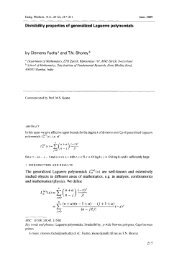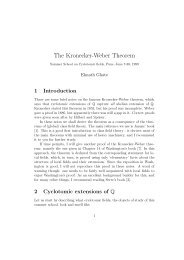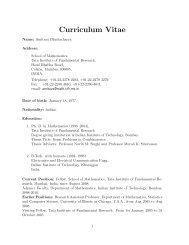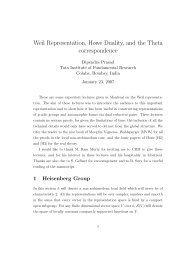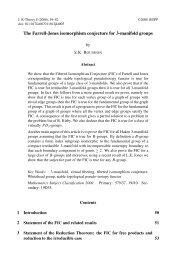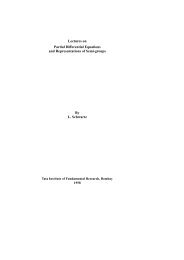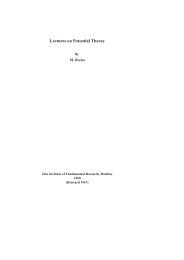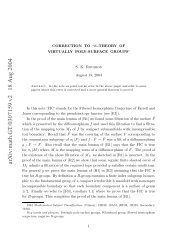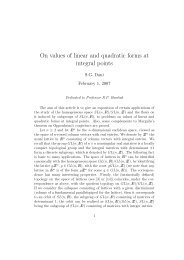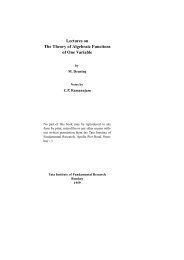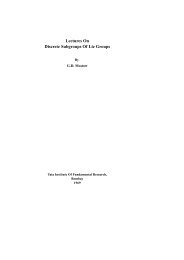Extensions of Schur's irreducibility results - Tata Institute of ...
Extensions of Schur's irreducibility results - Tata Institute of ...
Extensions of Schur's irreducibility results - Tata Institute of ...
Create successful ePaper yourself
Turn your PDF publications into a flip-book with our unique Google optimized e-Paper software.
Shanta Laishram and T. N. Shorey(only when a = 48). In each <strong>of</strong> the equations thus obtained, we note that 8|2 α since n 512. Out<strong>of</strong> all the equations, we need to consider only those which are valid modulo 8 and hence we restrictto those equations. Here we use p βp ≡ 1 or p modulo 8 according as β p is even or odd, respectively.They are now expressed as the Thue equationX 3 + AY 3 = Band we solve them in PariGp. For instance, let a = 32. Then we obtain equations <strong>of</strong> the form3 β 3− 2 α = 1, 11 β 11− 2 α = 1, 3 β 311 β 11− 2 α = 1. By modulo 8, we find that β 3 , β 11 , β 3 + β 11are even for the first, second and third equation, respectively. This imply 3 β 32 − 1 = 2, 3 β 32 + 1 =2 α−1 giving 3 β 3= 9, 2 α = 8 for the first equation and 11 β 112 − 1 = 2, 11 β 112 + 1 = 2 α−1 givinga contradiction for the second equation. Observe that 2 α > 8 since n 512. Thus we are leftwith 3 β 311 β 11− 2 α = 1. For some 0 r, s, t 2, we have α + r, β 3 − s, β 11 − t all multiples <strong>of</strong> 3and from −2 α+r + 2 r 3 s 11 t 3 β3−s 11 β11−t = 2 r , we obtain the Thue equations X 3 + AY 3 = B withB = 2 r , A = 2 r 3 s 11 t , 0 r, s, t 2 and X a power <strong>of</strong> 2 and 33|AY . There are 27 possibilities <strong>of</strong> pairs(A, B). If A = 1, then B = 1 and we factorize X 3 + Y 3 to get a contradiction and the case A = 1 isexcluded. For all other values <strong>of</strong> (A, B) than those given by t = 2, we check in PariGp that none <strong>of</strong>solutions (X, Y ) <strong>of</strong> Thue equations thus obtained satisfy the condition X a power <strong>of</strong> 2 and 33|AYexcept when A = 66, B = 2 where X = −4 and Y = 1 from which we obtain n = 1024. When t = 2,from 3 β3−s+3 11 β 11−2+3−2 3−r 3 3−s·11·2α+r−3 = 3 3−s·11, we obtain the Thue equations X 3 +AY 3 = Bwith B = 3 3−s ·11, A = 2 3−r 3 3−s ·11, 0 r, s 2 and 33|X and Y is a power <strong>of</strong> 2. We check again inPariGp that none <strong>of</strong> solutions (X, Y ) <strong>of</strong> these Thue equations thus satisfy the condition 33|X andY is a power <strong>of</strong> 2. Hence we need to consider n = 1024 when a = 32. For another example, let a = 48.We obtain the equations <strong>of</strong> the form 5 β 5− 2 α = 3, 7 β 7− 2 α = 3, 5 β 5− 7 · 2 α = 3 and 5 β 57 β 7− 2 α = 3.First three equations are excluded modulo 8 and for the last equation, we find that β 5 , β 7 are bothodd. Modulo 7 imply 3|(α − 2) or 3|(α + 1) and hence from the equation −2 α+1 + 2 · 5 β 57 β 7= 6,we obtain the Thue equations X 3 + AY 3 = B with B = 6, A = 2 · 5 s 7 t , 0 s, t 2 and X a power<strong>of</strong> 2 and 70|AY . When t = 2, from 5 β5−s+3 7 β7+1 − 4 · 5 3−s · 7 · 2 α−2 = 3 · 5 3−s · 7, we obtain theThue equations X 3 + AY 3 = B with B = 21 · 5 3−s , A = 28 · 5 3−s , 0 s 2 and 35|X and Y is apower <strong>of</strong> 2. We check in PariGp that all the solutions (X, Y ) <strong>of</strong> these Thue equations are excludedexcept when (A, B) = (70, 6) where X = −4, Y = −1 and we obtain n = 512. Hence we need toconsider n = 512 when a = 48. Similarly, all other a’s are excluded except when a ∈ {20, 24} wherewe obtain (n, a) ∈ {(4096, 20), (1920, 24)}.Thus we now exclude the cases (n, a) ∈ {(4096, 20), (1920, 24), (1024, 32), (512, 48)}. We takep = 2 and show that φ ′ j < 1 for all 1 j n. This is shown by checking ord 2(∆ j )−ord 2 ( ( nj)) < jfor j such that ord 2 (∆ j ) j for these pairs (n, a). Hence they are all excluded.AcknowledgmentsA part <strong>of</strong> this work was done when the second author was visiting Max-Planck <strong>Institute</strong> for Mathematicsin Bonn during February-April, 2009 and he would like to thank the MPIM for the invitationand the hospitality.ReferencesDus99 P. Dusart, Inégalitiés explicites pour ψ(X), θ(X), π(X) et les nombres premiers, C. R. Math. Rep.Acad. Sci. Canada 21(1)(1999), 53-59.Dus02 P. Dusart, Sur la conjecture π(x + y) π(x) + π(y), Acta Arith., 102 (2002), 295-308.Fil96 M. Filaseta, A generalization <strong>of</strong> an <strong>irreducibility</strong> theorem <strong>of</strong> I. Schur, In Analytic number theory, Vol16



